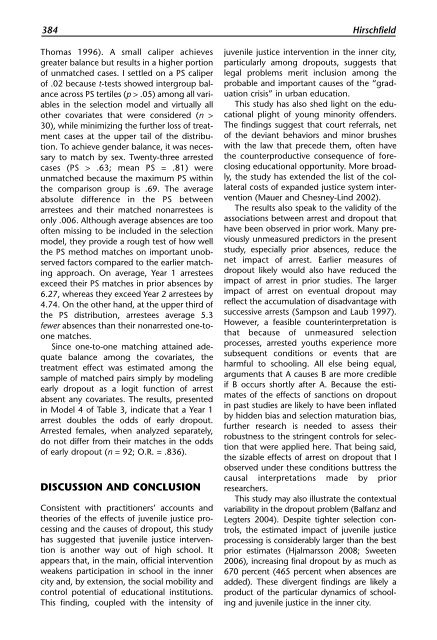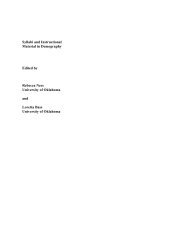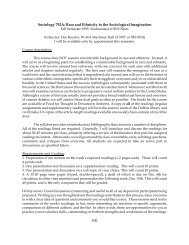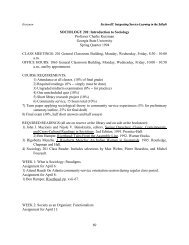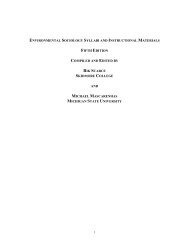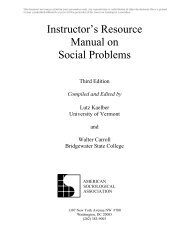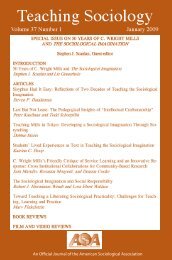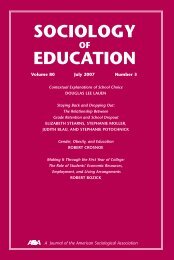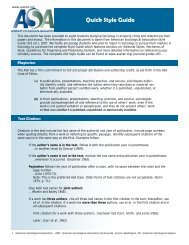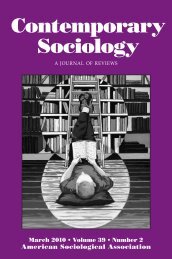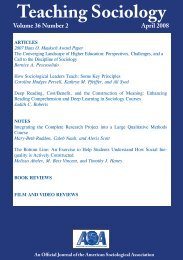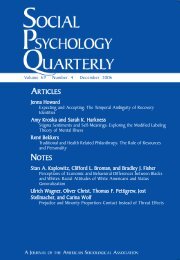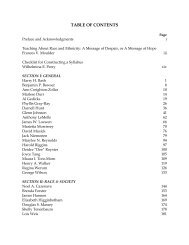SOCIOLOGY EDUCATION - American Sociological Association
SOCIOLOGY EDUCATION - American Sociological Association
SOCIOLOGY EDUCATION - American Sociological Association
You also want an ePaper? Increase the reach of your titles
YUMPU automatically turns print PDFs into web optimized ePapers that Google loves.
384 Hirschfield<br />
Thomas 1996). A small caliper achieves<br />
greater balance but results in a higher portion<br />
of unmatched cases. I settled on a PS caliper<br />
of .02 because t-tests showed intergroup balance<br />
across PS tertiles (p > .05) among all variables<br />
in the selection model and virtually all<br />
other covariates that were considered (n ><br />
30), while minimizing the further loss of treatment<br />
cases at the upper tail of the distribution.<br />
To achieve gender balance, it was necessary<br />
to match by sex. Twenty-three arrested<br />
cases (PS > .63; mean PS = .81) were<br />
unmatched because the maximum PS within<br />
the comparison group is .69. The average<br />
absolute difference in the PS between<br />
arrestees and their matched nonarrestees is<br />
only .006. Although average absences are too<br />
often missing to be included in the selection<br />
model, they provide a rough test of how well<br />
the PS method matches on important unobserved<br />
factors compared to the earlier matching<br />
approach. On average, Year 1 arrestees<br />
exceed their PS matches in prior absences by<br />
6.27, whereas they exceed Year 2 arrestees by<br />
4.74. On the other hand, at the upper third of<br />
the PS distribution, arrestees average 5.3<br />
fewer absences than their nonarrested one-toone<br />
matches.<br />
Since one-to-one matching attained adequate<br />
balance among the covariates, the<br />
treatment effect was estimated among the<br />
sample of matched pairs simply by modeling<br />
early dropout as a logit function of arrest<br />
absent any covariates. The results, presented<br />
in Model 4 of Table 3, indicate that a Year 1<br />
arrest doubles the odds of early dropout.<br />
Arrested females, when analyzed separately,<br />
do not differ from their matches in the odds<br />
of early dropout (n = 92; O.R. = .836).<br />
DISCUSSION AND CONCLUSION<br />
Consistent with practitioners’ accounts and<br />
theories of the effects of juvenile justice processing<br />
and the causes of dropout, this study<br />
has suggested that juvenile justice intervention<br />
is another way out of high school. It<br />
appears that, in the main, official intervention<br />
weakens participation in school in the inner<br />
city and, by extension, the social mobility and<br />
control potential of educational institutions.<br />
This finding, coupled with the intensity of<br />
juvenile justice intervention in the inner city,<br />
particularly among dropouts, suggests that<br />
legal problems merit inclusion among the<br />
probable and important causes of the “graduation<br />
crisis” in urban education.<br />
This study has also shed light on the educational<br />
plight of young minority offenders.<br />
The findings suggest that court referrals, net<br />
of the deviant behaviors and minor brushes<br />
with the law that precede them, often have<br />
the counterproductive consequence of foreclosing<br />
educational opportunity. More broadly,<br />
the study has extended the list of the collateral<br />
costs of expanded justice system intervention<br />
(Mauer and Chesney-Lind 2002).<br />
The results also speak to the validity of the<br />
associations between arrest and dropout that<br />
have been observed in prior work. Many previously<br />
unmeasured predictors in the present<br />
study, especially prior absences, reduce the<br />
net impact of arrest. Earlier measures of<br />
dropout likely would also have reduced the<br />
impact of arrest in prior studies. The larger<br />
impact of arrest on eventual dropout may<br />
reflect the accumulation of disadvantage with<br />
successive arrests (Sampson and Laub 1997).<br />
However, a feasible counterinterpretation is<br />
that because of unmeasured selection<br />
processes, arrested youths experience more<br />
subsequent conditions or events that are<br />
harmful to schooling. All else being equal,<br />
arguments that A causes B are more credible<br />
if B occurs shortly after A. Because the estimates<br />
of the effects of sanctions on dropout<br />
in past studies are likely to have been inflated<br />
by hidden bias and selection maturation bias,<br />
further research is needed to assess their<br />
robustness to the stringent controls for selection<br />
that were applied here. That being said,<br />
the sizable effects of arrest on dropout that I<br />
observed under these conditions buttress the<br />
causal interpretations made by prior<br />
researchers.<br />
This study may also illustrate the contextual<br />
variability in the dropout problem (Balfanz and<br />
Legters 2004). Despite tighter selection controls,<br />
the estimated impact of juvenile justice<br />
processing is considerably larger than the best<br />
prior estimates (Hjalmarsson 2008; Sweeten<br />
2006), increasing final dropout by as much as<br />
670 percent (465 percent when absences are<br />
added). These divergent findings are likely a<br />
product of the particular dynamics of schooling<br />
and juvenile justice in the inner city.


